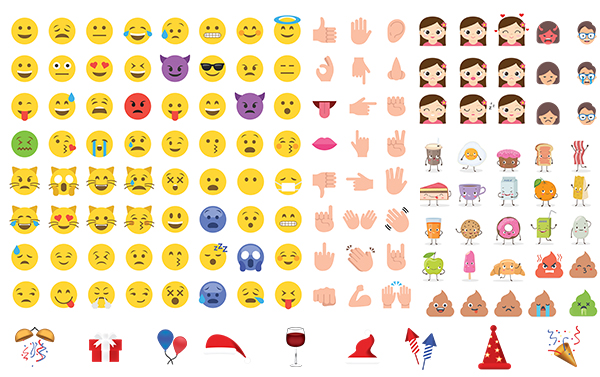Emojis: they’re cute, they’re fun, they’re expressive and over 92% of the digitally savvy population use them (Source: AdWeek).
Once limited to our personal texts and emails, over the past few years they’ve entered the professional space, with more and more brands successfully using them in their communications. But while emoji marketing is a growing trend, is it right for your business and what do you need to do to get it right?

The rise of emoji marketing
Born in Japan, emojis only really took off globally when Apple introduced emoji support to iPhones back in 2011. Since then, it’s become part of our native online language, even overtaking text-speak, and businesses have started to recognise its power.
From SMS messages to social media updates and email subject lines, brands today are using emojis across a range of marketing channels. Bigger brands, from Coca-Cola to Taco Bell, have even based national advertising campaigns around them. Now it looks like emojis are about to become a feature in Google AdWords – although this has yet to be confirmed.
According to a recent study by AppBoy, emoji use by brands in campaigns grew by 606% between 2015 and 2016. Some have been successful, others not so much, but the fact is for a jump that significant there must be something in the emoji that is turning businesses on.
Why the professional emoji love?
There are a number of reasons why businesses are embracing the emoji. Firstly, great marketing follows the latest trends, it pays attention to what consumers are doing and follows suit. We love using emojis, so it makes sense that businesses would start communicating in them.

Secondly, they are effective in conveying personality and emotion quickly and effectively – something in business we are always looking to achieve in order to form connections and grow relationships.
Finally, they are successful engagement boosters. Because of their colourful pictorial nature, they can help brand stand out, whether in an overcrowded inbox or in Google’s search engine results – and standing out means more clicks and more conversions.
In addition, audiences are positively open to them with 39% of participants in the AppBoy study saying they are fun, 18% saying they are normal and 13% saying they are relatable (Source: AppBoy).
Should you follow the trend?
But while emoji marketing is accepted and offers many benefits, it’s not a tactic every business should pursue. In addition, even if it is something that you can use advantageously, you need to ensure you’re doing it right to get the positive results it promises.
If you’re yet to use emojis in your marketing, there are three major factors you need to consider before you do:
- Industry suitability: emojis have been used widely and successfully by B2C businesses, but may not be as relevant or effective in B2B because they can still be deemed unprofessional and childish especially in more formal contexts. Look at which businesses are currently using them to assess their compatibility with your industry.
- Audience affinity: knowing your audience is critical to knowing if emojis would be a win or fail for your business. What channels do they use? Are they a demographic that widely uses emojis or are they not yet ready or willing to be communicated to in pictures? While research shows that all ages do use them, the regularity at which they do varies, plus women tend to be more receptive than men.
- Relevance to message: just because you can use emojis and they could work for your industry and audience doesn’t mean you should – at least not in every instance. Before you add them to your emails or social media updates, consider whether they add value to your message as well as whether they sit comfortably with your overall brand ideals.
Emoji best practices
If you think emojis could work for your business, before you start introducing them you need to ensure you know how to do so appropriately and effectively. There are many potential pitfalls when incorporating these quirky little characters – so take note:
- Understand their meanings – there are around 2,000 emojis supported on current platforms – do you know what they all mean? Chances are you don’t. Not all are obvious and some have different meanings depending on context and audience so it pays to know. org is a great resource to help with this. If emojis are used or interpreted incorrectly, it could have negative consequences for your brand.
- Use them sparingly – while the odd emoji here and there to enhance your message can really add value and increase positive engagement, use them too often and you’ll end up looking unprofessional. In addition, they’ll start to lose their impact.
- Don’t be cryptic – while emojis have become a global online language, you shouldn’t assume that everyone in your target audience speaks it fluently. If you’re using them, don’t just use them i.e. ensure they enhance your words not replace them. Chevrolet infamously created an entire press release in emoji and, while it was creative, it was widely misunderstood.

Put emojis to the test
Still unsure if emojis could work for your business or how effective they could be? The answer is simple: test them and see.
Next time you send out an email campaign, split test and try adding an emoji or two into the subject line of one and watch the results. In addition, try adding emojis to a few of your Facebook, Twitter or Instagram updates and pay attention to your engagement stats to see if they made any difference. But remember only include them when they enhance your message.
While they may not be suitable for all businesses, when used appropriately and sparingly for the right audience, emojis have the ability to grab attention, evoke emotion and ultimately boost your marketing efforts.